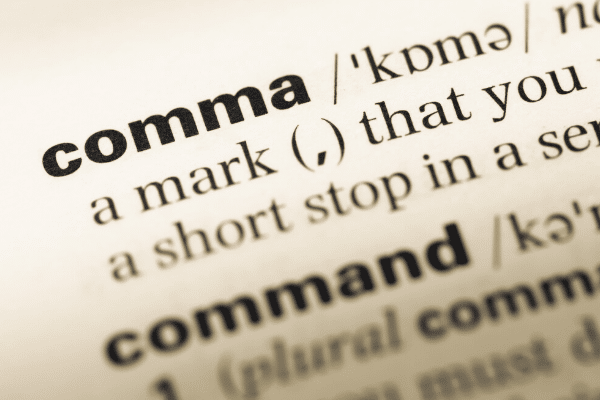
Commas have been around since the 15th Century, yet a lot of people don’t know how to use them. Do you?
Birth of the Comma
When Aldus Manutius was printing books in the 1490s, writers used the slash mark / to indicate a pause in speech. Back then, the slash mark designated a short pause while a dot (period) signified a hard stop. Manutius lowered the slash mark in relation to the line of text, and gave it a bit of curve.
Today, the comma changes in appearance across various font formats, but it is still the go-to punctuation mark writers use to break up text. What’s less universal, though, are the rules of when to use the comma.
8 Basic Rules for Comma Use
1. When Writing Dates
Use commas in dates to separate the date and the year, or to separate the day of the week and the date.
Examples:
Wednesday, January 1st
January 1, 2020
2. Writing Locations
Plop a comma between the city and state, or the city and country
Examples:
Chicago, IL
London, England
3. After an introductory element
Use a comma after an introductory element to reduce confusion (and sometimes, embarrassment)
Correct Example:
Let’s eat, Grandma!
Incorrect Example:
Let’s eat Grandma!
4. To Separate quotes
Commas separate quotes from the rest of the sentence.
Example:
“The slash mark looks terrible,” said Aldus, “I think I’ll invent the comma.”
5. Add to the conversation
Use a comma to add an informative tidbit to the sentence.
Example:
The book printer, Aldus Manutius, also invented the semi-colon by pairing up the comma with the colon.
6. When you put a dependent clause in front of an independent clause
Because it is missing a subject or a verb, a dependent clause cannot stand on its own and therefore needs to lean against an independent clause. A comma separates the dependent from the independent clause.
Example: Unhappy with its original name of ‘virgula,’ George Puttenham changed the name to ‘comma.’
7. When joining two independent clauses
Those independent clauses that stand on their own behave better when you put a comma between them.
Example:
‘Virgula’ is Latin for ‘twig,’ and ‘comma’ comes from a Greek word that means ‘cut off piece.’
8. Separate three or more items
Commas come in hand for separating three or more items. Whether you use the Oxford comma after ‘and’ or ‘or’ is a matter of personal preference and the source of heated debate.
Example:
Aldus Manutius was an Italian humanist, scholar, educator, and the founder of the Aldine Press.
Grammar can be hard, but commas should be easy. For more information on using commas and other punctuation, consult with a WriterAccess writer.
2024 State of Marketing Report
Your golden ticket to crush your goals with data-driven insights!
2024 State of Marketing Report
Your golden ticket to crush your goals with data-driven insights!

![[Rock NA] State of Marketing Reports 2024 – Comkt Hubspot State of Marketing Report 2024](https://rockcontent.com/wp-content/uploads/2022/07/Banner-Fino-Rock-Convert-2500-%C3%97-500-px-19.png)






